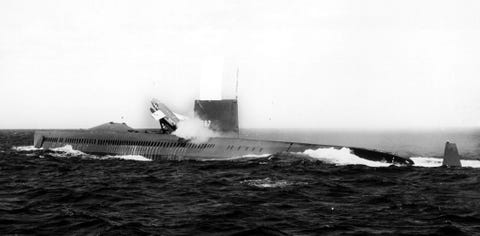The U.S. Navy Could Have Had a Submarine Aircraft Carrier
AN-1 would have carried eight fighter jets, had virtually unlimited range.
By Kyle Mizokami HI SUTTON
HI SUTTONDuring the 1950s, the advent of the atomic age forced the U.S. Navy to look at a number of alternate basing schemes for naval aviation. One such scheme was AN-1, an enormous nuclear-powered submarine that could launch eight fighter jets in just under eight minutes.
Although AN-1 was never built, it’s a fascinating look at a ship that could have been.

USS Halibut launching a Regulus cruise missile.
WIKIMEDIA COMMONS
The overwhelming firepower of nuclear weapons against naval forces, demonstrated at Bikini Atoll in 1946, prompted the Navy to consider alternate basing schemes for aircraft. One possibility was making jet fighters amphibious, able to take off directly from the sea, a concept that resulted in the failed Convair XF2Y Sea Dart. Another, bolder idea: placing aircraft carriers underwater.
Dubbed AN-1, the submarine aircraft carrier concept envisioned using a modified version of the Halibut-class guided missile submarine. The Halibut was larger than most boats; the reason was so it could accommodate the Regulus nuclear-tipped cruise missile. The Halibut-class subs carried five Regulus missiles, each of which was the size of a small jet fighter, in a hangar built into the hull. The missiles launched from a rail on the outside of the hull.

AN-1 with all eight aircraft in launch position.
HI SUTTON
AN-1 would have been a large submarine, nearly 500 feet long with a beam of 44 feet. It would have had an underwater speed of 16 knots, and thanks to a 15,000-horsepower shipboard nuclear power plant, could have cruised to any point on earth. The submarine would have had six bow-mounted torpedo tubes and two rear-firing tubes.
The sub’s real firepower, however, was a squadron of eight vertical-takeoff fighter jets. Designed by Boeing, the dagger-like jets would be raised up on launch platforms nose-first and then boosted into the sky by three 23,000-pound Wright SE-105 turbojets. Two of the engines would fall away to be recovered and reused later. The plane (which never left the design stage) had an estimated top speed of Mach 3.
Submarine authority HI Sutton, author of World Submarines: Covert Shores Recognition Guide, tells Popular Mechanics:
“The cruise missiles being used at the time were about the same size as a jet fighter so it makes sense that if a submarine could launch such a missile, then it could launch a jet fighter. The greater challenge was landing again.
"Boeing proposed tail-sitting jet fighters which take off and land vertically with the engine pointing downwards. This concept was validated in a series of experimental aircraft and found to be viable but also extremely difficult to control. The pilot has to land while sitting upside down and looking over their shoulder."

Proposed Boeing Mach 3 fighter.
HI SUTTON
Back in the 1950s, the whole U.S. military was pivoting toward atomic war, and it was in a nuclear conflict the AN-1 would have been most useful. The AN-1s wouldn't have been able to send up a useful number of fighter jets for a convention war, but the sub could have surfaced near the Soviet Union or China to launch nuclear-armed fighters from an unexpected direction.
Alternately, AN-1 submarines could sit off the coasts of Asia and Europe and form America’s first line of fighter defense against nuclear-armed intercontinental bombers, intercepting them far from the continental United States. The uncertainty about where the aircraft carriers would pop up would have sown doubt in the foe's mind that a surprise nuclear attack against the U.S. was feasible.
AN-1 was a concept ahead of its time. Today, the increase of high-tech threats against aircraft carriers, including hypersonic weapons and anti-ship ballistic missiles, could force them to adapt and go underwater, just like the Navy was considering 60 years ago. Unmanned aerial vehicles, launched and recovered from submarines could someday perform many of the same missions performed by carrier aircraft.
The United States already builds drones and submarines far larger than AN-1, and it may be just a matter of time before it combines the two into a stealthy and lethal package.
No comments:
Post a Comment